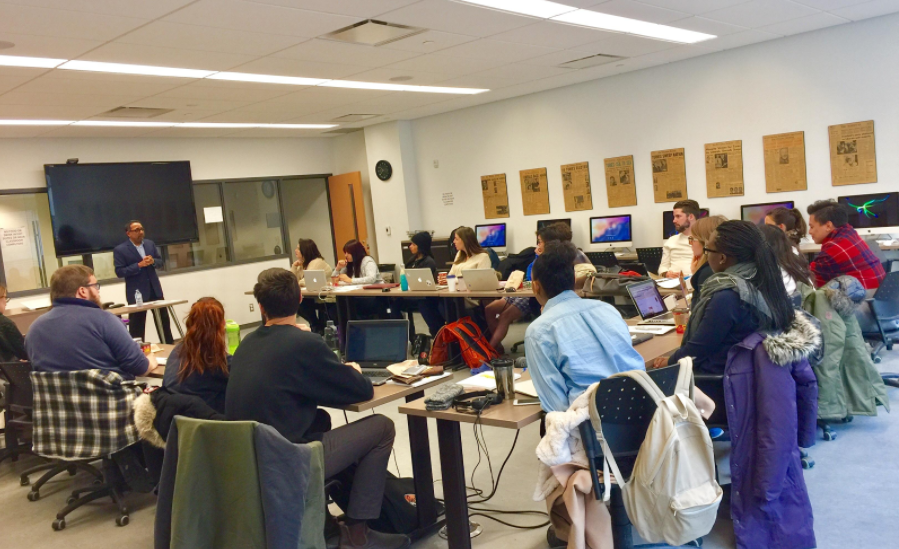By George Abraham
I recently spoke to a great class of graduate students at Carleton on the topic of diversity in journalism. I anticipated the students would be bored out of their wits – seeing my “lecture” as an imposition by a professor, rather than required material for a career in Canadian journalism.
What I encountered was very different. In fact, the entire session was driven by thoughtful questions – ranging from the genesis of New Canadian Media to the dos and don’ts of implementing diversity in newsrooms.
Two questions from very different students stuck out: one, from a student of colour who asked me a question that at first stumped me and almost caused me to do a double take. She is from Scarborough, which in my parlance is immigrant-rich. Her question (I paraphrase): Why should the white folks in Scarborough care about diversity? What’s in it for them? Why should they care?
The second intriguing question came from a white student who, while recognizing the need for diversity and acknowledging that he would face fewer barriers than some of his classmates of colour, asked, ‘What can I do to be more diverse in the journalism I practice as a future professional?’
These questions came from a classroom that was far more representative of the Canadian population than the graduate class I attended at Carleton in 2002-2003 as a newcomer to Canada. The students I was speaking to were a “colourful” bunch, without necessarily implying that any of them were foreign-born or immigrant themselves, but rather “colour” as the easiest signifier of diversity. They seemed to have diversity ingrained in them.
To the question about Scarborough, I spoke at some length to the “demographic drivers” that will upend our current understanding of “minority” communities. For example, Canada reached a tipping point last year when all our labour market growth came from immigration. More importantly, I said, since the 1970’s, our newcomers have come from Asia, Africa and Latin America—not western and central Europe, unlike in the decades before.
These newcomers are not only adding continually to the “visible minority” population, but they bring worldviews and socio-political mores that are very different from earlier generations of immigrants to Canada. Mosques and churches are filling up. Canada is being re-imagined before our very eyes.
Part of the explanation for the rise of a new populist sentiment in the U.S. has been attributed to the looming ‘white minority’ scenario that hovers over America. Current demographic projections suggest that whites will be outnumbered by Hispanics, blacks, Asians and multi-racial Americans by 2044.
So, understanding the cultural and socio-political mores of our newcomers is not just a good thing to do, it’s the smart thing to do. A journalism rooted in the mirror principle—that is, a newsroom that reflects the society it is writing about—will help us navigate the intervening years of change.
Journalists of tomorrow, like the white graduate student who asked me the question, are a further guarantee that we can contemplate a future that is much more diverse in its thinking and outlook. He wanted practical advice. I pointed to a recent piece I wrote for Policy Options “Privileging Diversity in Canadian Newsrooms” (which was required reading for this particular class), suggesting that legacy news organizations should tap into the rich cadre of ethnic media journalists to be better able to portray multicultural Canada.
There are literally hundreds of news organizations that serve immigrant communities in all kinds of media formats. Their reporters represent an under-used talent. They could report from within their communities, offering the colour, texture and nuance that are so sadly lacking in our present journalism.
Having more diverse voices, names and faces reflected on our pages, websites, TV screens and on radio, would help restore the credibility of journalists in the eyes of many Canadians. God knows we need to be more credible than used car salesmen. It would revive hyper-local reporting – inexpensively. It would raise professional standards across the board, offering a lifeline for hundreds of immigrants who arrived in this country wanting to be journalists, but never got a break.
It would surely address the mirror part of the much-hyped Shattered Mirror report put out by the Public Policy Forum. (Full disclosure: I participated in the Forum’s Ottawa roundtable and wrote a Memo on ethnic media for the report.)
I’m proud to say New Canadian Media has helped several newcomers get exactly that sort of break. The Israr Kasana Show on OMNI, produced from Calgary, is but one example. The executive producer of that show, Israr Kasana from Pakistan, wrote a heart-rending piece for us in April of 2016, headlined “Save us From Depression: Immigrant Journalist”.
I can think of no better trade-off than this: giving immigrant journalists an opportunity to use their skills, while mainstream newsrooms bolster the breadth and depth of their coverage of marginalized immigrant communities. A smart newsroom manager would see “win-win” written all over this.
George Abraham is founder and publisher of New Canadian Media.

